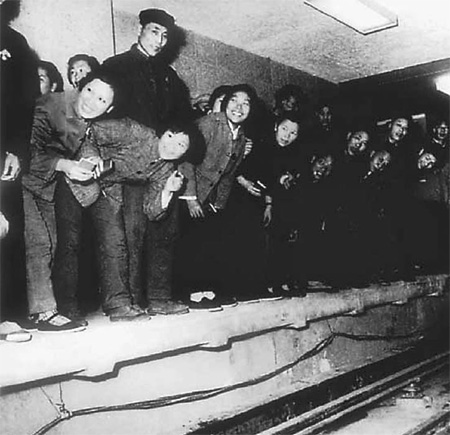Society
In the beginning, there was just one line ...
By Li Ye (China Daily)
Updated: 2011-04-10 08:09
 |
Large Medium Small |
Beijing's metro network was proposed more than 50 years ago to mixed reactions. Li Ye traces the history.
 |
|
It is 1969, and workers who took part in the subway construction eagerly wait for the first train to travel through the tunnel which they helped build. [Photo/Xinhua] |
The first subway line proposed in September 1953 was meant to be a wartime bunker. At the time, decision-makers in government felt that an underground train system was an extravagance. As Premier Zhou Enlai had put it: "Subway construction in Beijing is completely for wartime need. If it were for mass transportation use, 200 more buses would do the work".
The chief engineer of the then Beijing subway preparatory office, Xie Rende, remembered these famous words well, but his colleagues managing Beijing's current vast network of underground rail lines may find it hard to imagine now.
It was a different world, a very different city. Beijing in the 1950s boasted a population that barely reached 3 million. The number of cars on the road was little more than 5,000. People moved around on foot, on bicycles or by rickshaw. Buses were few and far between and bus-riders considered an elite.
Investing in a subway line meant a serious commitment of resources and expertise and posed a challenge for the new republic.
| ||||
Five Soviet experts eventually arrived in Beijing in 1956, bringing with them comprehensive technical information from their participation in the 1931 Moscow subway construction. Meanwhile, from 1953 until 1960, thousands of Chinese students were sent to the Soviet Union to learn about underground railway planning, design and construction.
There were initial disagreements between the Soviet experts and the Beijing metro authority, and the Chinese eventually gave in to a revised route with stops at Shijing Shan, Fuxing Men and the Beijing Railway Station.
Again, both sides disagreed about the proposed depth of the tunnels. Guided by the principle of putting "defense before transport", Beijing advocated going 60 meters below ground. The Soviets disagreed, pushing for shallower tubes just 5 to 12 meters below ground. The Chinese were finally convinced, not by the Soviets but by the geographical conditions of the Forbidden City, which are not conducive to deep tunneling.
By mid-1960, China and the Soviet Union had fallen out. Thousands of Soviet aid experts were withdrawn, and within China, the economy was traumatized by consecutive natural disasters.
In 1961, Beijing's subway program was postponed indefinitely.
With tightened purse strings and no foreign help, home-trained technicians and new overseas returnees sustained the program. As the economy gradually got back on track, the focus on subway construction was sharpened.
In February 1965, Chairman Mao Zedong ordered the restart of the construction program.
Later that year in June, Beijing's subway Phase I broke ground at Yuquanlu Road, West Beijing. It was attended by a host of political heavyweights, but the event happened under a media blackout and no news reports of the ceremony were filed because of confidentiality concerns.
But the hiccoughs started even before the tunneling began. A minor but critical flaw was detected during the final auditing of the blueprint and more than 30,000 plans were sent back to the drawing board for another three months.
Although the construction of the first subway line was covered in secrecy, the increased traffic in West Beijing gave away what was going on. The first casualties, though, were the huge trees that were uprooted to make way for the line.
On October 1, 1969 - just in time to mark the 20th anniversary of the founding of the People's Republic of China - the first subway line roared to life at Gucheng Station with Premier Zhou Enlai and a few founding fathers as its first passengers.
The Beijing underground became a major tourist attraction and out-of-town visitors descended just to gawk at the magnificent marble-paved passages, grand pillars and lighting.
But the issues of subway safety and train scheduling continued to plague the line. Only a month after it opened, a disastrous fire caused by an electricity leak claimed three lives and injured more than 100.
It took 10 years of trial and error before most of the technical problems were conquered. In 1981, 32 years after it was first proposed, the Beijing Metro Line 1 was finally fully in operation.



